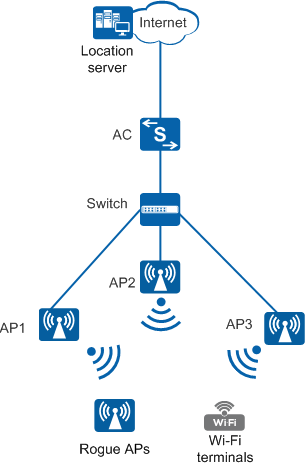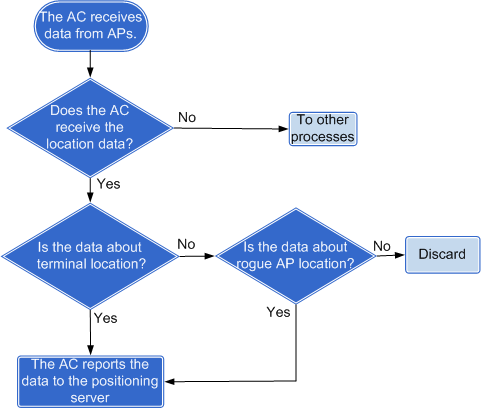Wi-Fi Terminal Location
Basic Concepts
As shown in Figure 1, the terminal location system includes at least three APs, one AC, and one location server. Functions of each component are as follows:
- AP: The APs collect wireless signals. The APs periodically switch channels to collect strength information about terminal signals in the surrounding environment on each channel and report the collected information to the location server.
- AC: The AC delivers terminal location configurations to the APs. In addition, the AC also classifies and filters the information received from the APs based on the device type (such as authorized terminals and rogue APs).
- Location server: The location server functions as the location server and display terminal in the location system. The location server computes the signal transmission model according to locations of APs and obstacles, and calculates locations of terminals, rogue APs, or Wi-Fi interference sources based on the RSSI information collected by each AP. The display terminal draws maps and displays locations of the devices on the map.
Implementation Principles
Terminal location technology locates terminals as follows:
APs collect strength information about radio signals and forward the information to the location server.
- The APs periodically switch channels to collect frames sent from terminals in the surrounding environment on each channel and record frame information including RSSI information, timestamp, data rate, and channel information. RSSIs are essential in determining whether a terminal is near or far from the APs.
- The APs encapsulate the collected radio signal information into UDP packets and report the data to the location server in the following two modes:
APs report collected data to the AC. Then, the AC reports the data to the location server.
When the network between the APs and the location server is not reachable, the APs report data to the AC first. The AC then filters information about terminals and rogue APs before reporting the data to the location server.
The APs directly report the collected data to the location server.
If the network between the APs and the location server is reachable, and the AC is not required to identify unauthorized APs, configure the APs to directly send data to the location server, which decreases CPU usage of the AC and reduces impacts of the location function on services.
For details about the format of Wi-Fi terminal location packets, see [WLAN]Q&A: What Is the Format of Wi-Fi Terminal Location Packets.
The AC reports the information received from APs to the location server.
As shown in Figure 2, after receiving information from the APs, the AC processes the information as follows:- Determine whether the data received from the APs is location data. If not, the data is processed in other ways.
- If the AC receives the location data, the AC processes the data in the following way: if the data is about terminal locations, the AC reports the data directly to the location server; if the data is about authorized AP locations, the AC discards the data; if the data is about rogue AP locations, the AC reports the data to the location server.
The location server computes the location information.
The location process involves the offline phase and online phase.- Offline phase: The location server divides the whole network into multiple equal area grids, computes the signal transmission model according to environment features (indoor/outdoor and obstacle features), calculates the theoretical differences among RSSIs of a STA in the grid to all APs based on the imported AP location information, and stores the data into the database.
- Online phase: At least three APs report terminal information to the location server after receiving the terminal information. The location server compares the information received from the APs with the information in the database to obtain the location of the terminal.

